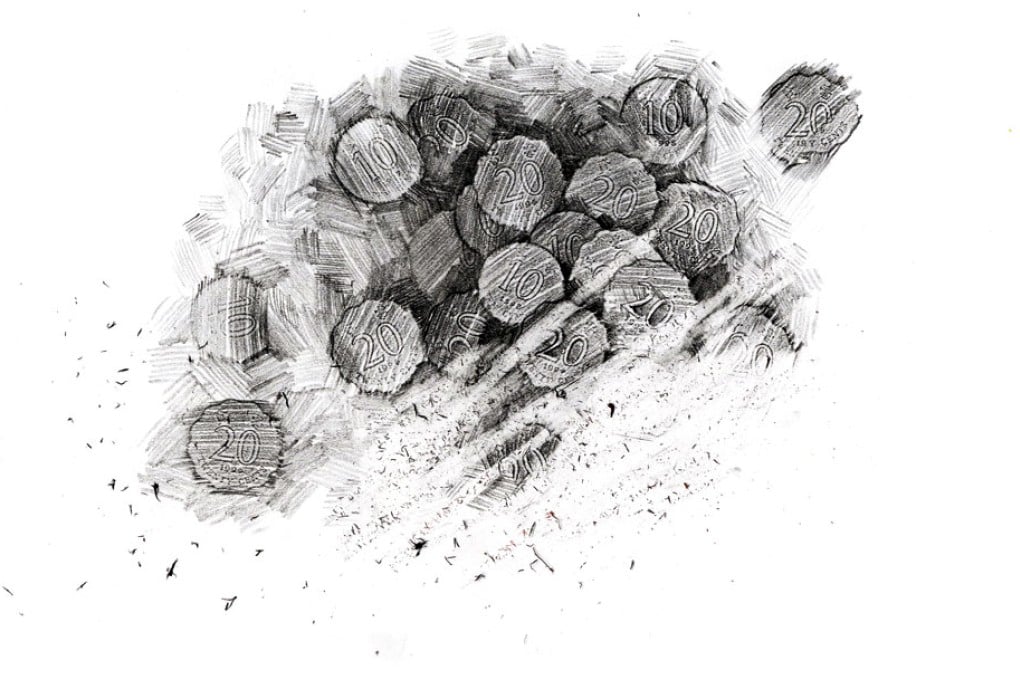Lack of Common Cents
Hong Kong’s poorest families are struggling to buy food with 10 and 20-cent coins as more small stores refuse to accept them. Are the banks to blame? Grace Tsoi reports

About two weeks ago, a 60-year-old man went to a wet market in Kwun Tong and bought some frogs for supper. After weighing them, the vendor asked him to pay $19.5 so he paid the sum in coins—with quite a few 10 and 20-cent coins. The vendor told him that the stall did not accept such coins. The man was enraged and threatened the vendor by claiming to be a triad member. The vendor waved his knife sparking a scuffle between the two men. Many will find this crazy story funny. After all, it is rather amusing that some people will fight so passionately over small change. However, to some of the less fortunate people in our community, cents mean a great deal and handling 10 and 20-cent coins remains a daily challenge.
Take a walk in any wet market in Hong Kong and you will see that the prices are set in dollars. Very few stalls will charge customers 10 cents, 20 cents or even 50 cents for groceries—regardless of whether it’s a catty of vegetables, a kilo of meat or a bag of shrimps. According to the Census and Statistics Department, the consumer price index soared 2.8 percent in June this year alone. From 2007 to 2009, the inflation rate has increased 2 percent, 4.3 percent and 0.5 percent respectively. Therefore, it should be no surprise that cents are being phased out. Mr. So, a vendor who sells meat in Sham Shui Po asks: “If there was a 10-cent coin lying on the floor, would you bother to pick it up?”
It has become an unwritten rule in wet markets that vendors are no longer willing to take 10- and 20-cent coins, even though most of the vendors do not have signs telling customers this. It is not actually illegal for businesses to refuse 10 and 20-cent coins, although it is not good customer service and could drive people away. The main reason behind this dislike of small change is the handling fee charged by banks if small businesses want to deposit coins into their accounts. Hang Seng Bank will exempt the handling fee usually charged when businesses deposit coins if there are 500 coins or less. If businesses have more than 500 coins, the bank will charge two percent of the deposit amount. However, the minimum handling fee is $50. The Bank of East Asia adopts a similar policy—but it has a lower exemption limit on the number of coins. It will only exempt the handling fee if there are 300 coins or below. Do the math and you will see why vendors are rejecting 10 and 20-cent coins. If a business collects 501 10-cent coins, which equals to $50.1, it will need to pay the minimum handling fee of $50. This means the business will only have 10 cents after depositing all those coins in the bank.
“It actually inflicts a loss on people because we cannot use 10- and 20-cent coins now,” says Professor Raymond So, Academic Leader of Finance at Hang Seng Management College. With banks charging small businesses handling fees, the burden is shifting to ordinary citizens because there are fewer chances for us to use these pennies, even though they are legal tender in Hong Kong.
For the majority of us, unusable pennies can’t really be defined as a big problem. We might find it annoying, but it won’t greatly affect our lives. However, the story is totally different for the low-income families. Qiu Qiuyan is a single mother with two daughters, who are five and six. After getting her identity card earlier this year, her family is now living on Comprehensive Social Security Assistance and they have a monthly allowance of about $7,000. However, Qiu needs to pay about $3,000 for rent leaving only $4,000 to feed her family. “We need to plan very carefully or otherwise we will not have enough money,” Qiu says. For a typical dinner for the entire family, Qiu will only spend $5 on a catty of vegetables, $15 on fish and $10 on meat. From time to time, she gathers a large pile of cents at home but she finds it very hard to spend them because so many vendors do not accept them anymore.
Qiu and her family don’t use public transport and walk everywhere. This means they can’t use the coins on the bus or MTR. She could do her shopping in the larger shops or supermarkets but she is on a very tight budget and the prices are higher than the local markets. She says: “If I buy two cartons of milk from the grocery store they cost $8.9. But if I go to the supermarket they cost at least $10.9.” Qiu has about $80 worth of 10 and 20-cent coins at home and is incredibly frustrated that she can’t use the money to feed and clothe her family. This is a problem facing many of Hong Kong’s low-income families and the situation appears to be getting worse. Sze Lai-shan, community organizer at the Society for Community Organization (SOCO), says: “If shops and stalls stop accepting 10 and 20-cent coins it will cause a lot of trouble for poor people. Some of them just earn a few dollars and cents by collecting waste paper and soft drink cans. They save every single penny they earn.”